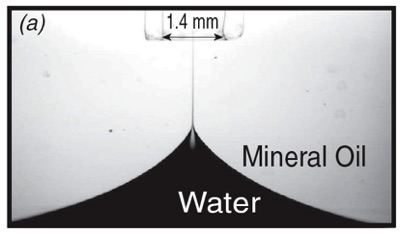Myelin figures
Selective withdrawal

Myelin figures are long thin cylindrical structures that typically grow as a dense tangle when water is added to the concentrated lamellar phase of certain surfactants. Mylein figures were produced in isolation, allowing a detailed study of their growth and stability. Myelins only form and grow in the presence of a driving stress; when the stress is removed, the myelins retract.
Fluids change shape easily in response to stress. In some cases, the change is so dramatic that the fluid interface changes topology. An example is fluid entrainment by selective withdrawal. Here, a change in topology occurs when shear stresses cause the initially smooth interface between two immiscible fluids to erupt into a spout that pierces through the entraining fluid. Some fluid transformations, such as drop breakup, proceed as some physical dimension approaches zero, becoming much smaller than the macroscopic dimensions of the flows. Such a separation of length scales often leads to universal behavior as the dynamics approach a singularity where physical quantities diverge. Other fluid transformations, such as selective withdrawal, proceed via a discontinuous jump, resembling first-order hysteretic transitions.
“Myelin figures: The buckling and flow of wet soap,” L.-N Zou, PRE 79, 061502 (2009).
“Stability and growth of myelin figures,” L.-N. Zou, S.R. Nagel, PRL 96, 138301 (2006).
“Spout States in the Selective Withdrawal of Immiscible Fluids through a Nozzle Suspended above a Two-Fluid Interface,” S.C. Case and S.R. Nagel, PRL 98, 114501 (2007).
“Scaling at the Selective Withdrawal Transition through a Tube Suspended above the Fluid Surface,” I. Cohen and S. R. Nagel, Phys. Rev. Lett. 88, 074501 – 1-4 (2002).
“Using Selective Withdrawal to Coat Micro Particles,” I. Cohen, H. Li, J. L. Hougland, M. Mrksich, and S. R. Nagel Science 292, 265-267 (2001).